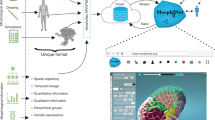Abstract
Morphing was initially developed as a cinematic effect, where one image is seamlessly transformed into another image. The technique was widely adopted by biologists to visualize the transition between protein conformational states, generating an interpolated pathway from an initial to a final protein structure. Geometric morphing seeks to create visually suggestive movies that illustrate structural changes between conformations but do not necessarily represent a biologically relevant pathway, while minimum energy path (MEP) interpolations aim at describing the true transition state between the crystal structure minima in the energy landscape.
Access this chapter
Tax calculation will be finalised at checkout
Purchases are for personal use only
Similar content being viewed by others
References
Vonrhein C, Schlauderer GJ, Schulz GE (1995) Movie of the structural changes during a catalytic cycle of nucleoside monophosphate kinases. Structure 3:483–490
Gerstein M, Krebs W (1998) A database of macromolecular motions. Nucleic Acids Res 26:4280–4290
Flores S, Echols N, Milburn D, Hespenheide B, Keating K, Lu J, Wells S, Yu EZ, Thorpe M, Gerstein M (2006) The database of macromolecular motions: new features added at the decade mark. Nucleic Acids Res 34:D296–301
Kleywegt GJ (1996) Use of non-crystallographic symmetry in protein structure refinement. Acta Cryst D-Biol Cryst 52:842–857
Ye YZ, Godzik A (2004) FATCAT: a web server for flexible structure comparison and structure similarity searching. Nucleic Acids 32:W582–W585
Weiss DR, Levitt M (2009) Can morphing methods predict intermediate structures? J Mol Biol 385:665–674
Farrell DW, Speranskiy K, Thorpe MF (2010) Generating stereochemically acceptable protein pathways. Proteins 78:2908–2921
Kim MK, Jernigan RL, Chirikjian GS (2002) Efficient generation of feasible pathways for protein conformational transitions. Biophys J 83:1620–1630
Metzner P, Schutte C, Vanden-Eijnden E (2006) Illustration of transition path theory on a collection of simple examples. J Chem Phys 125:084110
Vanden-Eijnden E, Tal FA (2005) Transition state theory: variational formulation, dynamical corrections, and error estimates. J Chem Phys 123:184103
Weinan E, Vanden-Eijnden E (2010) Transition path theory and path finding algorithms for the study of rare events. Annu Rev Phys Chem 61:391–420
Van Erp TS (2012) Dynamical rare event simulation techniques for equilibrium and nonequilibrium systems. Adv Chem Phys 151:27–58
Elber R (2005) Long-timescale simulation methods. Curr Opin Struct Biol 15:151–156
Schiltter JM, Engels M, Kruger P, Jacoby E, Wollmer A (1993) Targeted molecular dynamics simulation of conformational change—application to the T-R transition in insulin. Mol Simul 10:291–308
Koppole S, Smith JC, Fischer S (2007) The structural coupling between ATPase activation and recovery stroke in the myosin II motor. Structure 15:825–837
Noe F, Fischer S (2008) Transition network for modeling the kinetics of conformational changes in macromolecules. Curr Opin Struct Biol 18:154–162
Tirion MM (1996) Low-amplitude elastic motions in proteins from a single-parameter atomic analysis. Phys Rev Lett 77:1905–1908
Bahar I, Rader AJ (2005) Coarse-grained normal mode analysis in structural biology. Curr Opin Struct Biol 15:586–592
Kantarci-Carsibasi N, Haligoglu T, Doruker P (2008) Conformational transition pathways explored by Monte Carlo simulation integrated with collective modes. Biophys J 95:5862–5873
Korkut A, Hendrickson WA (2009) Computation of conformational transitions in proteins by virtual atom molecular mechanics as validated in application of adenylate kinase. Proc Natl Acad Sci U S A 106:15673–15678
Maragakis P, Karplus M (2005) Large amplitude conformational change in proteins explored with a plastic network model: adenylate kinase. J Mol Biol 352:807–822
Berkowitz M, Morgan JD, McCammon JA, Northrup SH (1983) Diffusion-controlled reactions- a variational formula for the optimum reaction coordinates. J Chem Phys 79:5563
Huo SH, Straub JE (1997) The MaxFlux algorithm for calculating variationally optimized reaction paths for conformational transitions in many body systems at finite temperature. J Chem Phys 107:5000–5006
Jonsson, H., G. Mills, and K. W. Jacobsen. 1998. Nudged elastic band method for finding minimum energy paths of transitions. In Classical and Quantum dynamics in condense phase simulations. World Sci., Singapore. 285-404.
Fischer S, Karplus M (1992) Conjugate peak refinement- an algorithm for finding reaction paths and accurate transition states in systems with many degrees of freedom. Chem Phys Lett 194:252–261
Chu JW, Voth GA (2007) Coarse-grained free energy functions for studying protein conformational changes: a double well network model. Biophys J 93:3860–3871
Franklin J, Koehl P, Doniach S, Delarue M (2007) MinActionPath: maximum likelihood trajectory for large-scale structural transitions in a coarse-grained locally harmonic energy landscape. Nucl Acids Res 35:W477–W482
Wiley, D. F., N. Amenta, D. A. Alcantara, D. Ghosh, Y. J. Kil, E. Delson, W. Harcourt-Smith, F. J. Rolf, K. S. John, and B. Haman. 2005. Evolutionary morphing. In IEEE Viz. 431-438
Slice DE (2007) Geometric morphometrics. Annu Rev Anthropol 36:261–281
Henzler-Widman KA, Kern D (2007) Dynamic personalities of proteins. Nature 450:964–972
Mueller K, Brown LD (1979) Location of saddle points and minimum energy paths by a constrained simplex optimization procedure. Theor Chim Acta (Berl) 53:75–93
Author information
Authors and Affiliations
Editor information
Editors and Affiliations
Rights and permissions
Copyright information
© 2014 Springer Science+Business Media,New York
About this protocol
Cite this protocol
Weiss, D.R., Koehl, P. (2014). Morphing Methods to Visualize Coarse-Grained Protein Dynamics. In: Livesay, D. (eds) Protein Dynamics. Methods in Molecular Biology, vol 1084. Humana Press, Totowa, NJ. https://doi.org/10.1007/978-1-62703-658-0_15
Download citation
DOI: https://doi.org/10.1007/978-1-62703-658-0_15
Published:
Publisher Name: Humana Press, Totowa, NJ
Print ISBN: 978-1-62703-657-3
Online ISBN: 978-1-62703-658-0
eBook Packages: Springer Protocols




